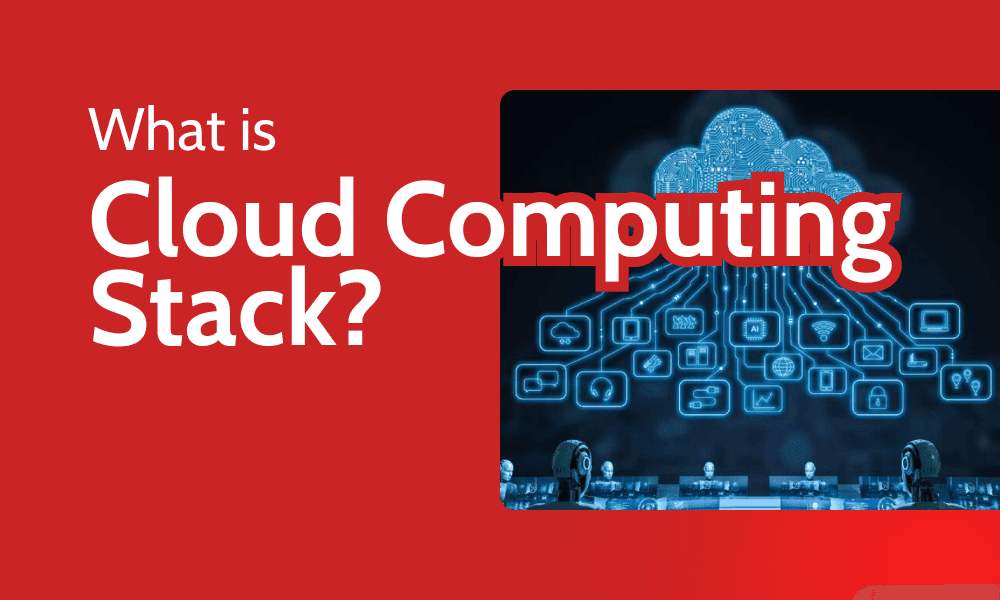Cloud computing runs on layers of resources with varying degrees of abstraction — the ability to simplify processes for users — stacked on top of each other. This abstraction serves to cover different needs, including costs, management responsibilities and control.
By understanding a cloud computing stack and its layers, you can ensure you make informed choices when selecting cloud services. This guide explores cloud computing stacks, their layers, why they matter and how to choose the most fitting service model for your needs.
Definition: What’s a Cloud Computing Stack?
A cloud computing stack consists of layers of service delivery models a business uses; it defines the level of configuration, control and abstraction that goes into each service while conceptualizing how cloud delivery models build on each other.
A cloud computing stack is often made up of three service delivery models: Infrastructure as a Service (IaaS), Software as a Service (SaaS) and Platform as a Service (PaaS). However, in extended stacks, you’ll find other cloud delivery models, including Container as a Service (CaaS), AI as a Service (AIaaS), Function as a Service (FaaS) and many more.
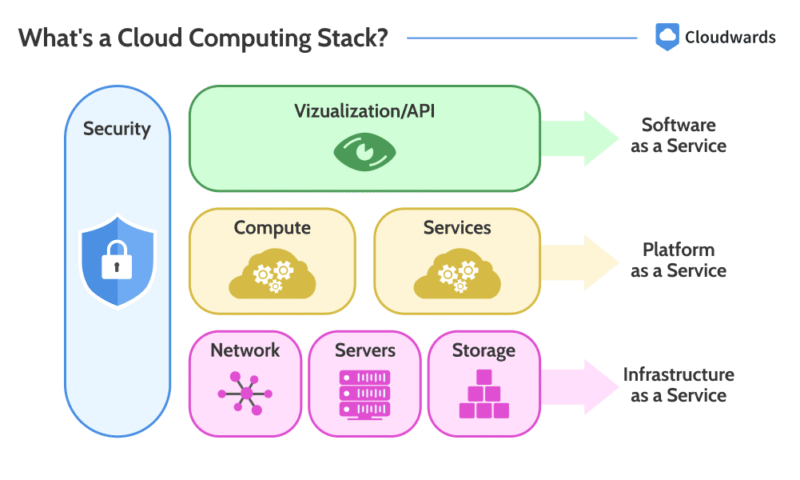
This is an example of a cloud computing stack and how a business would use
different delivery models.
Layers of a Cloud Computing Stack
In simple terms, cloud computing involves building software on application development platforms, which are built on virtualized computing resources. Accordingly, the primary layers of a cloud computing stack are IaaS, PaaS and SaaS.
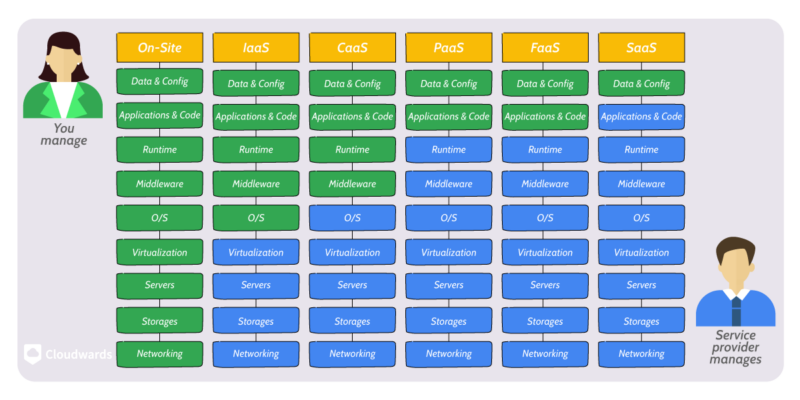
Infrastructure as a Service (IaaS)
The Infrastructure-as-a-Service (IaaS) layer of a cloud computing stack features the basic building blocks of the cloud, including compute, data storage and the network. It delivers virtual machines, storage and network resources (pretty much a virtual data center) over a network, typically the internet.
IaaS offers the least abstraction and the highest level of control over the underlying infrastructure. It’s built on physical hardware, and every cloud solution is also built on this model.
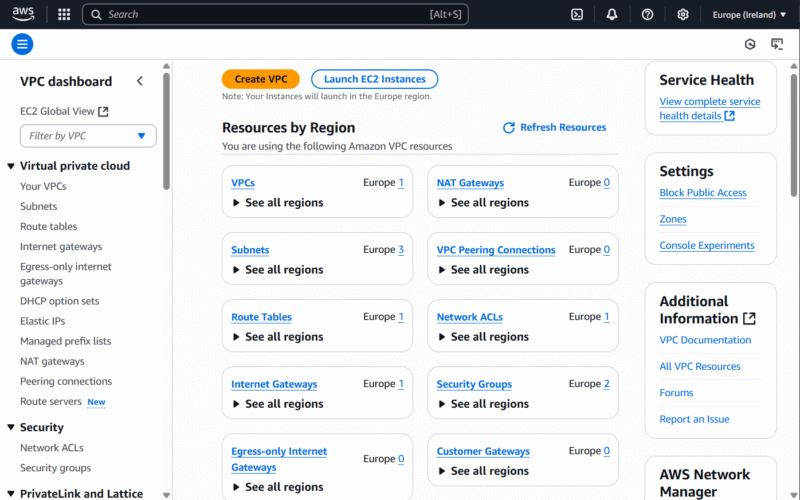
Amazon VPC is a networking infrastructure that ensures privacy
through isolation in the cloud.
Platform as a Service (PaaS)
The PaaS layer offers a pre-configured environment for application deployment. The PaaS layer takes care of most of the infrastructure configuration for you — for the most part, all you have to do is come with the application code and data.
Compared to IaaS, PaaS features more abstraction and less control. If you want control over features like middleware and the operating system, PaaS is not ideal. That said, if you want to focus more on the quality of your application, it’s perfect.
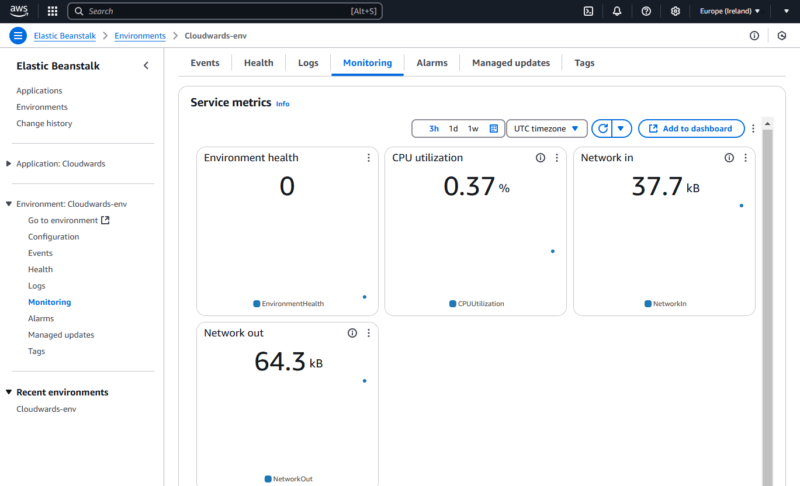
Elastic Beanstalk is one of the most popular PaaS services.
Software as a Service (SaaS)
The Software-as-a-Service (SaaS) layer delivers ready-to-use, fully managed software applications to end users. It is the final layer of the cloud computing stack, and it almost never requires configuration at an expert level.
SaaS offers the highest level of abstraction of all cloud service delivery models, but as you’d expect, it also offers the least control. Therefore, it’s a great option if you’re looking for a plug-and-play resource rather than a solution you intend to build from the ground up.
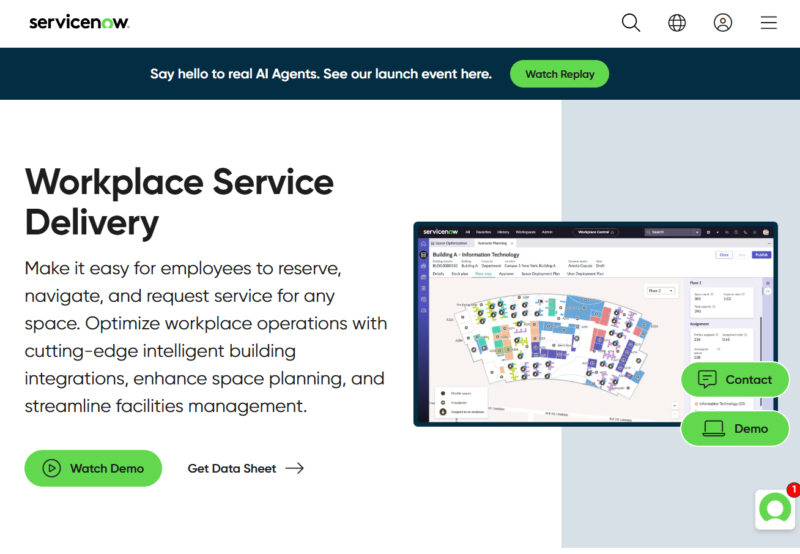
ServiceNow offers a range of SaaS solutions built for specific business functions.
What Are the Different Cloud Deployment Models?
Cloud deployment models determine the ease of accessing data. This, in turn, influences data security and privacy in the cloud. We share an overview of the four cloud deployment models below:
- Private cloud: Private cloud deployments offer dedicated environments for single users or organizations and are ideal for handling sensitive data. They can be deployed on-premises or hosted by third-party cloud providers. With on-premises private cloud, you manage data center operations; otherwise, a third party handles it.
- Public cloud: Public cloud deployments offer a shared environment for multiple users. You can access them over an internet connection, and third-party cloud service providers like AWS, Google Cloud and Azure host them.
- Hybrid cloud: Hybrid cloud deployments are a combination of private and public cloud. Typically, the goal is to take advantage of private cloud’s security and public cloud’s flexibility in a unified environment.
- Multi-cloud: In multi-cloud deployments, you create a cloud environment consisting of services from various cloud service providers. This helps with cost optimization and enhanced redundancy while avoiding vendor lock-in.
Real-World Examples of Cloud Stack Use
To illustrate real-world examples of cloud stack use, let’s look into Amazon Prime Video’s cloud computing stack on AWS. As part of its Infrastructure-as-a-Service (IaaS) offering, Prime Video uses EC2 for its compute needs and S3 for streaming analytics. At the PaaS layer, it uses Amazon Kinesis to analyze streaming data.
At the SaaS layer is Prime Video itself, which the end user interfaces with. Customer relationship management (CRM), email marketing and payroll tools, which are used in the day-to-day administrative operations of Prime Video, are all SaaS as well.
Why the Stack Matters for Cloud Services
A cloud computing stack matters because it offers clarity of a business’ cloud infrastructure management system, which helps you optimize cost, make better cloud service choices, and streamline your operations.
- Cost optimization: The cost components differ at each layer of a cloud computing stack, so how you estimate the running costs of services at each layer will differ. Similarly, the precision of cost forecasting will differ. For instance, the periodic costs of a SaaS solution can be predicted more accurately since SaaS is typically subscription-based.
- Furthermore, you’re less likely to overprovision and overspend when using SaaS and PaaS compared to IaaS tools. That said, SaaS and PaaS solutions are an option only when you can yield a level of control over systems. All in all, understanding these layers, their pricing and resource management is crucial to efficient cloud spending.
- Informed service selection: When choosing a cloud service, factors like expertise and business goals determine the most fitting selection. That said, understanding cloud computing stacks can help you understand how those factors should guide your service selection.
- For instance, if you’re looking to deploy an e-commerce website, you should opt for a service like Elastic Cloud Compute (EC2) only if you have a skilled developer. Without one, the service would be unusable.
Then again, even with a skilled developer, EC2 may not be the best choice if the overall running costs exceed the revenue generated from the website. At such times, you may consider PaaS or SaaS, which offer cost savings through reduced overhead and easier cost management.
- For instance, if you’re looking to deploy an e-commerce website, you should opt for a service like Elastic Cloud Compute (EC2) only if you have a skilled developer. Without one, the service would be unusable.
- Streamlined operations: Understanding the level of control and resource configuration in your business operations will guide you toward enhanced efficiency. For instance, if you’re not using a custom operating system for your app deployment, you may not need direct control of your servers. Therefore, you could opt for a PaaS solution instead of an IaaS one.
Which Cloud Service Model Is Right for Me?
When selecting a cloud service model, you should consider how much control you need over the infrastructure. In addition, pay attention to available expertise, the desired time to market and costs.
- Control: If you want maximum control over your cloud resources, the IaaS service model would be perfect. However, if you want to yield infrastructure control but wish to retain control over the application itself, opt for PaaS.
- With IaaS, you can control the operating system, middleware, runtime and storage, while with PaaS, you control your application’s code and data. Unlike IaaS and PaaS, SaaS leaves you with almost no control; the provider manages both the application and the infrastructure layer.
- Expertise: If you’re looking for maximum control (IaaS), you’ll need professionals skilled in infrastructure management, cybersecurity and solutions architecture. However, if you’re considering PaaS, you’ll generally need application developers. As for SaaS, usage requires little to no technical expertise.
- Time to market: If you desire faster time to market, PaaS and SaaS should top your list of considerations. SaaS solutions are ready to go out of the box, so they offer the fastest time to use. The PaaS model is also fast, but its time to market depends on the speed of application development.
- Costs: Of the three models, IaaS tools are the most likely to come with hidden charges. However, because they’re typically billed based on usage, they offer potential savings on auto-scaled resources.
- Like IaaS, PaaS can be usage-based, making it similarly cost-effective. Moreover, PaaS comes with less overhead, which equals more savings. In some cases, PaaS is subscription-based, making it easier to predict costs. SaaS is also typically subscription-based and has little to no overhead.
The Future of the Cloud Stack
The level of inclusiveness of the three main cloud service models will evolve over time, especially PaaS. We’ve already seen this happen: As people embrace serverless tools and microservices architecture, new service models have been carved out of PaaS, including Database as a Service (DBaaS), Container as a Service (CaaS), Mobile Backend as a Service (MBaaS) and Function as a Service (FaaS).
As for emerging layers of the cloud stack, look out for Artificial Intelligence as a Service (AIaaS) and Edge as a Service (EaaS). Based on current trends, AIaaS will intersect the PaaS and SaaS layers, while EaaS will exist between the PaaS and IaaS layers.
You can also expect increased abstraction in the future of the cloud stack, which will make these services more accessible to people with limited technical skills. In addition, you can expect more automation and extensive AI integration across layers.
Final Thoughts
When you understand the workings of a cloud computing stack, you can readily visualize how your cloud architecture fits into your project and optimize existing resources. Furthermore, you can grasp the level of control you have over your cloud infrastructure and how much management it requires.
Have you worked on any cloud computing projects recently? What was your cloud computing stack like? Which of these emerging cloud service models are you anticipating the most? Share your thoughts with us in the comments below. Thank you for reading.
FAQ: Cloud Stack Architecture
-
The cloud computing stack is a theoretical framework consisting of layers of cloud service models. It highlights how a business layers cloud computing services on top of each other to fulfill all its service needs and why they require varying levels of management.
-
A cloud computing stack is primarily used as an infrastructure management tool to build, deploy and deliver software. However, it also helps with informed service selection, cost optimization and streamlining operations.
-
The four types of cloud computing based on deployment models are hybrid cloud, private cloud, public cloud and multi-cloud.

